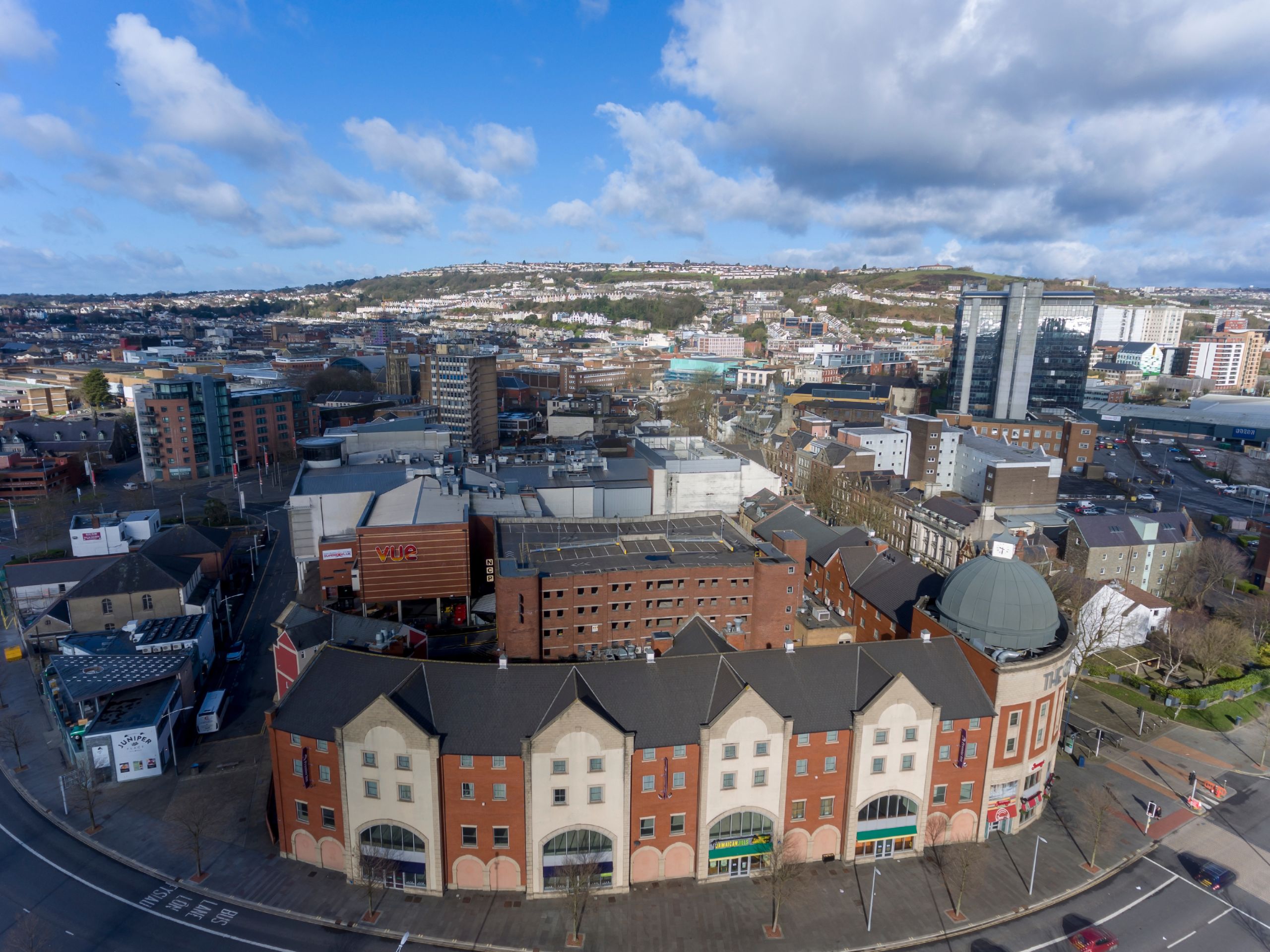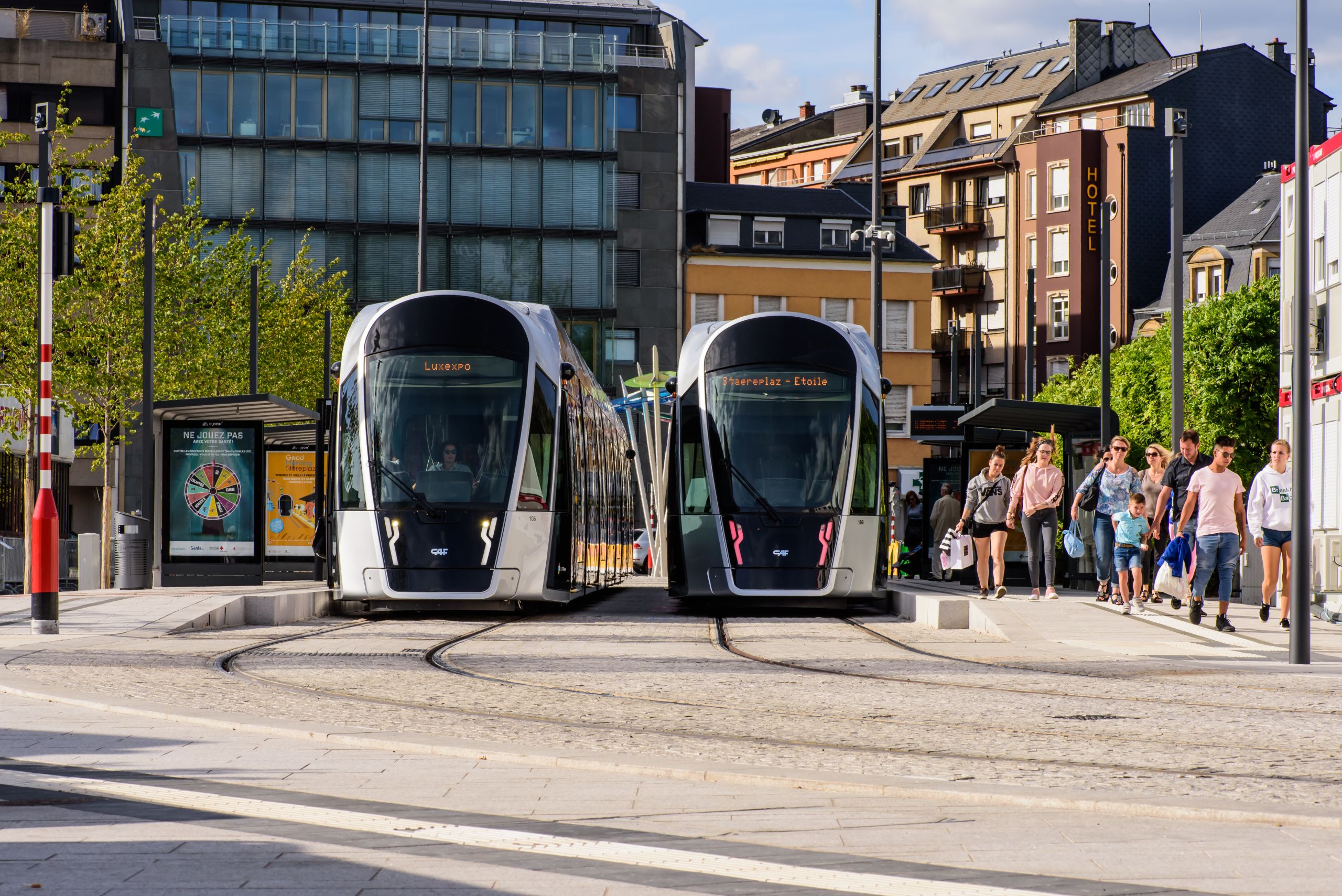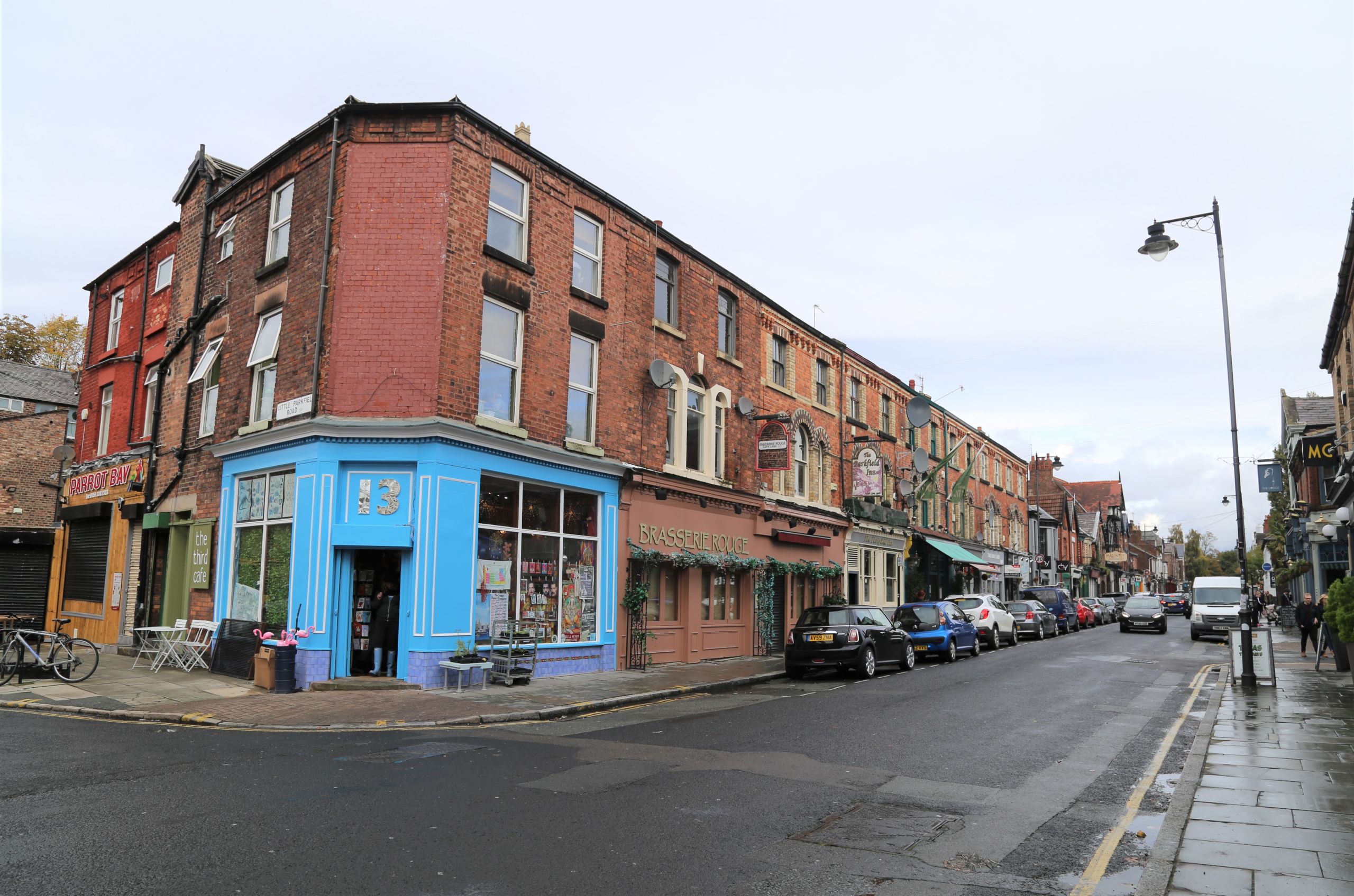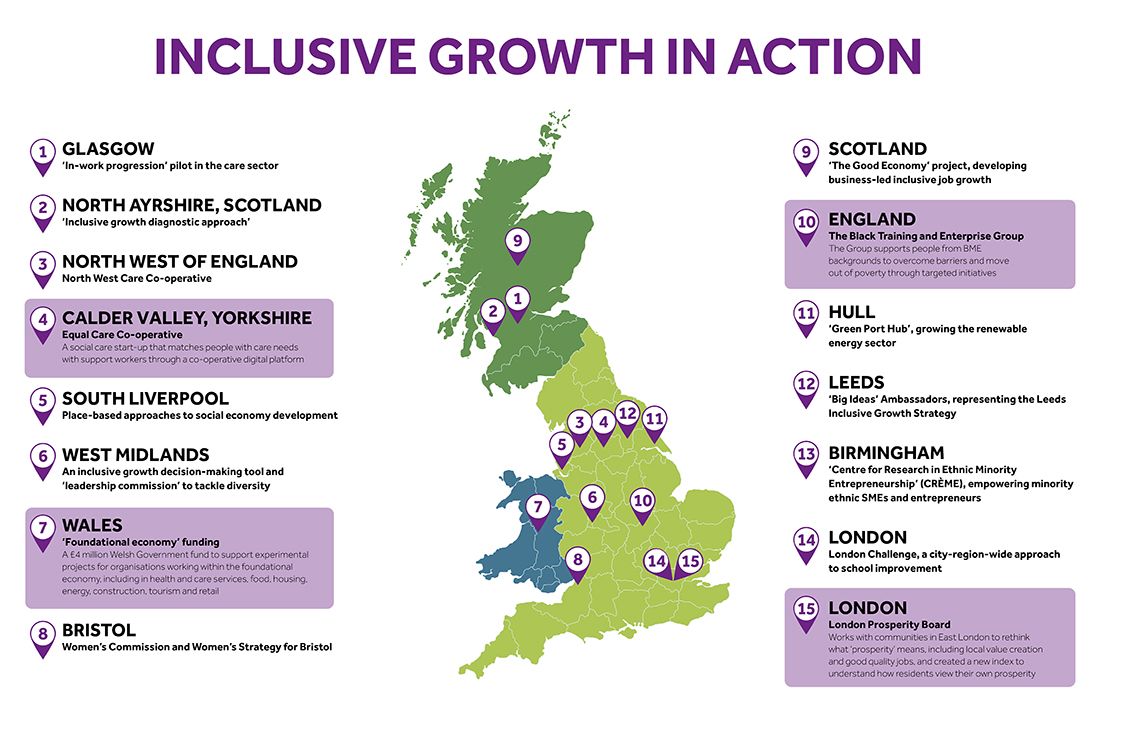Case Studies
Inclusive Growth in Greater Manchester 2020 and beyond: Taking Stock and Looking Forward
Ruth Lupton, Ceri Hughes, Alex Macdougall, Hannah Goldwyn-Simpkins and Annika Hjelmskog
Inclusive Growth Analysis Unit
November 2019

Link back to the main report:
Inclusive Growth in Greater Manchester 2020 and Beyond: Taking Stock and Looking Forward

Case study 1: Developing a broader vision and different metrics for inclusive growth
The London Prosperity Board is a partnership between the Institute for Global Prosperity (IGP) at UCL and London government, public agencies, businesses, the third sector and local communities in East London. It aims to “rethink what prosperity means for London”, recognising challenges to the idea that prosperity simply equals greater wealth and that economic growth is the only way to increase standards of living. A key principle for the Board is that “prosperity means different things to different people and a good life can be lived in many ways”.
Based on four years of research with communities in East London on what prosperity meant to them, IGP developed a new five-part prosperity index. ‘Foundations of prosperity’ includes local value creation and good quality jobs, but the other domains are broader: health and healthy environments; opportunities and aspirations; belonging, identities and culture; and power, voice and influence. These are captured in 67 measures, some available from existing data sources but others collected from new household survey data. The Index has been used by organisations such as the London Legacy Development Corporation, the charity Community Links, and Hackney and Barking and Dagenham Councils, to inform their policies and understand how residents view their own prosperity. IGP is also developing a toolkit on how to work with local citizen scientists to translate these insights into action and evidence.

Case study 2: Embedding inclusive growth in decision-making and measurement
In 2017 the Scottish government and North Ayrshire Council developed an ‘inclusive growth diagnostic approach’ to identify barriers to sustainable inclusive growth and recognise investment decisions with the potential to deliver long-term change. This process identified drivers of inclusive growth across the external environment, local conditions, and social factors. These drivers included factors often identified in economic analysis such as infrastructure and skills but also the value and quality of jobs, and ‘social factors’ such as community empowerment, health, aspirations and childcare. Factors were then scored on a matrix of impact (on growth, inclusion and sustainability) and deliverability, in order to prioritise strategies and investment. The tool is designed to be used flexibly according to local circumstances and a user guide is publicly available.
The West Midlands Combined Authority (WMCA) has developed an inclusive growth decision-making tool for public sector organisations, to help assess whether and how proposed particular projects and interventions will contribute to inclusive growth. It is hoped that use of the tool will result in specific projects being modified to strengthen their contribution to inclusive growth outcomes and also, over time, lead to inclusive growth principles being more embedded across the WMCA partnership. There are four assessment criteria: fit with WMCA’s strategic priorities; contribution to inclusive growth in project; who will benefit (focussing on the five target groups of residents; e.g., furthest removed from employment or education opportunities); and contribution to good working practices.

Case study 3: Supporting businesses to lead growth
The Scottish government commissioned The Good Economy, in partnership with the Ethical Finance Hub, to report on the needs of the private sector and the role of business in driving inclusive jobs growth in the South of Scotland. The work included a local business survey to clarify how inclusive job growth is manifested in business and workplace practice, and identifying the main barriers that constrain business-led inclusive job growth. The survey received a high level of engagement and interest, and businesses identified transport and digital problems, ‘brain drain’ and a low skill base, as major barriers to growth in good jobs. Recommendations included transport improvements, the development of a holistic talent (human capital) retention and attraction strategy and investment in smart town centres.
The report also called for a regional Business for Inclusive Growth (B4IG), including a social enterprise growth fund, to support existing businesses, attract new businesses and enable start-ups to scale up, as well as a regional technology and information platform to support and connect small and medium-sized enterprises (SMEs) and link them to external markets, investors, funding sources and innovation clusters. The survey found that local business leaders are not fully aware of financing options and lack confidence in banks, and identified a need for new forms of finance, such as valuing IP and non-traditional security in investment decisions for growing creative and tech-based businesses. The report called for a place-based, innovative impact investment strategy bringing together public, private, social investors and philanthropic funders to meet local investment needs.

Case study 4: ‘System leadership’ of inclusive growth
The city of Leeds is challenging traditional models of leadership by appointing system leaders, who are experts in their fields beyond local government, to each become an Ambassador for one of the ‘Big Ideas’ that form the Leeds Inclusive Growth Strategy. Positions have been created for twelve voluntary ambassadors to champion one of the ‘ideas’, which are grouped into the themes of ‘People’, ‘Place’ and ‘Productivity’. Their initiatives are wide-ranging and include a Digital Enterprise business support programme for SMEs, a plan to double the size of the city centre, and work with the NHS to procure and recruit locally. The recruited Ambassadors are leaders in their fields, taking up an advocacy and influencing role to formalise the support and interest expressed by businesses and partners in Leeds to sign up to the city-region’s inclusive growth goals. For example, one of the initial appointments is Hiro Aso, who is well known for his work in the transport and infrastructure sector such as the development of Kings Cross station, London, and the Leeds Station Masterplan for HS2. The Ambassadors are part of the Leeds Inclusive Growth Delivery Partnership, for ‘organisations who have pledged to support our ambitions to come together to amplify and enhance our collective efforts’.

Case study 5: A long term approach to a more inclusive economy
Barcelona’s long-term economic strategy has overseen a reduction in inequalities at the same time as achieving substantial growth. The city has a tradition of supporting a more plural and diverse economy, a strategy argued by economists Joan Trullén and Vittoria Galletto as one that took an ‘active’ path to productivity growth – strengthening manufacturing, the knowledge economy, advanced services, the green economy and quality tourism, as opposed to a ‘passive’ path of promoting competitiveness through inward investment and cost-cutting. Particular support for SMEs, innovation, and transport and communication connectivity have allowed different strengths to emerge in different parts of the metropolis. This strategy has been supported by long-established organisations and structures that include Barcelona Activa, an incubator for entrepreneurs and start-ups created with the support of the City Council in 1986, and PEMB Barcelona, an independent, non-profit organisation with an activist and participatory philosophy, responsible for Metropolitan Barcelona’s strategic plan. This work is also supported by, among others: a social economy network funded by the city; the Catalan Network of the Solidarity Economy, which is working on developing mutual cooperation, social reporting and certification tools and creation of a social market sector; Momentum, a collaboration between the bank BBV and a Barcelona-based business school to support social entrepreneurship, and develop its ecosystem, through training, mentoring, finance, and networking.
Since 2008, Barcelona’s response to the financial crisis has been a ‘New Municipalist’ approach, focussed on addressing the various needs of the city’s residents with specific programmes. The city government is increasing the ‘in common’ (En Comú) spaces of the city, as a way to improve democracy, through experiments such as handing over public buildings to local communities, and launching a publicly held energy company. Empty rooftops of some public buildings are being transformed into accessible community farms. Barcelona Energia supplies municipal buildings and households with power from renewable sources as a way of increasing transparency in energy costs, breaking dependency on the existing electrical oligopoly and delivering the right to energy for all residents in response to 2015 legislation.

Case study 6: Economic gardening/growing local wealth
‘Economic Gardening’ describes an approach developed in Littleton, Colorado, in the late 1980s. Littleton responded to the loss of 8,000 jobs caused by the relocation of a major employer with a strategy of investing in the growth of local businesses. The focus was particularly on second-stage companies, those with between 10 and 100 employees and an annual revenue of at least $1m. After 25 years of this approach, Littleton saw a tripling of its number of jobs and population growth of a quarter. The approach has now been adopted as a state-wide pilot in Florida (GrowFL). Second stage firms with the greatest economic potential are matched with a team of professionals who provide market research and advice. Based on the performance of the initiative to date, an independent assessment suggests that between 2017 and 2027, GrowFL will create almost 44,000 private sector jobs.
Critically the jobs generated by these firms typically carry twice the salary of average jobs state-wide. The ‘economic gardening’ approach is attracting interest in other US cities and states as growing evidence suggests that they are more likely that inward investment to produce jobs for local people, and may provide a better return on investment than incentives to attract new firms.

Case study 7: Developing the foundational economy
As a new initiative to strengthen and support the ‘foundational’, or ‘everyday’ economy, the Welsh Government has designated a fund of more than £4 million to support a series of experimental projects from organisations that form part of that economy. These may include health and care services, food, housing, energy, construction, tourism and retail. The money is aimed at developing Wales’ regional economy and sharing its prosperity more widely. The goal of the investment is to overcome long-standing challenges for inclusive growth, such as improving workforce skills, recruitment and retention, boosting the impact of local spending, and involving citizens in service design.
The fund (of up to £100,000 for individual projects) is available to public, private and third sector organisations which can demonstrate their contribution to Wales’ foundational economy, provided that the projects take place in Wales and would not have existed without this financial support. Some of the fund’s initial recipients include: Swansea County Council for work supporting small construction firms to bid for local authority contracts; Circular Economy Wales for a ‘mutual credit system’ based on a Sardinian model allowing companies to trade with each other using credits, rather than cash, on the condition that they are spent within the regional economy; and The Gower Gas and Oil Project scheme providing work placement experience for young people at risk of falling out of the education system into unemployment.

Case study 8: Co-operative approaches to care
There is growing interest in the potential to develop co-operatives within the UK social care sector. This sector faces particular challenges given its very limited public funding. These early stage examples help to show how a co-operative approach to arranging social care could lead to improvements in the quality of care and in employment conditions for workers.
Equal Care Co-operative is a social care start-up based in Calder Valley, Yorkshire, which enables care recipients to be matched with support workers through a co-operative digital platform. The aim is to share power, giving people more control over the care that they receive and provide, whilst also addressing low pay and recruitment challenges in social care. As the founder, Emma Adelaide Back, explains “We’re not looking at increasing the price of social care, we’re just using the platform as a tool to achieve enough efficiencies so that more of it can go to the worker.”
The North West Care Co-operative (NWCC) is exploring the benefits of using a multi-stakeholder care co-operative model for people who have personal budgets. The approach here brings together people with similar care needs in small unincorporated care co-operatives which will then be supported by the service company, NWCC. The NWCC will employ the personal assistants and assume other liabilities, e.g. responsibility for complying with care regulations, thereby reducing some of the responsibilities and regulations individuals would otherwise have to negotiate. The first pilot co-operative has brought together young people with learning disabilities and their personal assistants and supporters.

Case study 9: A city-region-wide approach to school improvement
Between 2003 and 2011, schools in London were part of the London Challenge urban school improvement programme, England’s most substantial and successful example of a whole-system approach to improving quality and equity across a city-region. It covered schools only, not post-16 providers but nevertheless shows how city-region strategy and collaboration can generate improvements within the context of a national system. System-wide changes included: ‘Figurehead leadership’ (a London Schools Commissioner); a powerful sense of moral purpose and a positive framing; use of data to identify key priorities and link schools into similar ’families’; engagement of experienced school leaders as advisors; fostering of school-to-school collaboration and a focus on ‘Keys to Success’ schools and key boroughs facing the deepest challenges.
The Challenge also developed specific programmes to strengthen the teaching profession and enable tailored responses to London’s context. For example: changes to Inner London pay scales to aid teacher retention; housing subsidies; a Chartered London Teacher scheme which provided a unifying framework for professional development; bespoke training in relation to context; school-to-school support with professional development; new teacher and leader networks around issues like English as an Additional Language (EAL); a London student pledge relating to cultural and sporting opportunities; and a coordinated partnership with higher education institutions.

Case study 10: Sector approaches to skills and progression
As part of the Glasgow City Region City Deal, supported by the UK and Scottish Governments, a two-year In-Work Progression Pilot (2016-2018) in Glasgow’s care sector was designed to support the training and development of staff in low-income jobs, boosting their wages and reducing reliance on in-work benefits. Specialist support was offered to SMEs and their staff, and each care home involved received a tailored package of resilience-boosting advice and interventions. Reports from the programme demonstrate successes for both the care homes and their employees. The completion of 573 training opportunities has led to many staff involved in the pilot taking on additional responsibilities, using their new skills and competencies, and they have reported increases in levels of job satisfaction, which boosts wellbeing. The lessons from this pilot will be used to help shape a regional approach to improving in-work progression and addressing in-work poverty.
Hull’s growth sector and Green Port Hub, in the wake of the arrival of Siemens Gamesa (Europe’s largest wind turbine facilities), is transforming Hull and The Humber into a prominent centre for renewable energy, and the region faces difficulties in delivering a capable workforce to meet the challenges, and share the benefits, of the new industry. The Green Port Hub, and accompanying Fair Growth strategy, is prioritising investment in its local labour market to help more of Hull’s residents, particularly those who are further from the workforce, to access sustainable employment opportunities. The Hub will include: A Hull Employment Charter; extended and enhanced exit employment subsidy and mentoring to engage all growth sectors; a focus on improving outcomes for particular groups; and a programme to address the existing public services skills gaps.
A cyber sector Bridge Programme in New York City is the result of a partnership between the New York City Economic Development Corporation (NYCEDC) and technology bootcamp Fullstack Academy. They are offering a scholarship programme to low-income students and professionals in NYC to improve diversity in this tech sector. This includes $2million for 150 students from backgrounds which are under-represented in the cyber security sector, who come through LaGuardia Community College’s Cyber Bootcamp Bridge Programme. This six-week ‘bridge’ offers enhanced personal and professional support to prepare these students for the programming bootcamp. This is part of New York City’s aim to create more pathways into the tech sector for those from under-represented backgrounds, or those who are switching from another industry.

Case study 11: Clean inclusive growth
Seoul is a leading example of a city which is linking measures for climate change mitigation and adaptation with economic and social policies to promote citizen welfare. Its plan, the Promise of Seoul, brought a new focus on the ways in which the city’s responses to climate change could create opportunities for vulnerable groups and enable them to be active participants in re-shaping the city. For example, the Energy Welfare Public-Private Partnership Programme (EWPPP) focus on low income households that are at particular risk of fuel poverty. It provides them with energy efficiency upgrades such as solar panels and LED lights. At the same time, disadvantaged jobseekers are provided with skills and employability support to help them train to become energy consultants and welfare workers who carry out assessments of energy welfare support, home retrofitting and households’ energy performance. An Energy Welfare Civic Fund has been developed to invest in energy welfare programmes – with contributions from citizens, business and the savings generated from a virtual power plant bringing together 17 municipal buildings and 16 universities.

Case study 12: Free/subsidised public transport
Dunkirk has experimented with free bus travel for a year and evaluation suggests positive results. Bus journeys in the city have increased by 65% on weekdays, and 125% at weekends. The citizens of Dunkirk appear to be better connected to opportunities. As well reducing car journeys, it has increased mobility, and one third of new bus journeys are trips that did not take place at all before, suggesting an increase in travel and a reduction in isolation for those who were not mobile. The universal character of the scheme also works to reduce stigma. Passengers now include the refugee population in Dunkirk, who previously did not use the bus, as well as young people who were reliant on their parents, and it removes the very concept of ‘fare-dodging’.
The perceptions of town centre merchants witnessing increased business and a new clientele have been positive, and 31% of free bus users report an increase in city centre visits. Free bus travel was an affordable option here, as the bus network only accounts for 10% of Dunkirk’s public transport budget, and €10million has been set aside for essential improvements to the bus network. Trials of free or subsidised public transport are not always successful. For example, in Luxembourg the introduction of completely free city-wide public transport, without corresponding investment in infrastructure, is reported to have led to unsustainable strain on an already overstretched network, while the small reduction in travel costs, which were already heavily subsidised, made little difference to households in the context of high housing and living costs.

Case study 13: Linking growth plans to neighbourhood renewal
GrowSouth is a plan for the south side of Dallas, Texas, which has 45% of the city’s population yet provides only 15% of the tax base. The plan positions South Dallas as a growth opportunity, but recognises that realising that opportunity in the long term depends on focusing on quality of life as well as attracting new investment. Comprehensive plans for the area have included strengthening neighbourhoods and schools, improving the housing stock and dealing with problematic landlords as well as investments in transport and industrial infrastructure. Recognising that areas need a critical mass of development to change market perceptions, the area has been divided into smaller ‘focus areas’, each with a core investment area and a wider improvement plan. These are divided into those already on a clear path to successful growth, those with certain anchors in place and with potential to build from there, and those where public investment (for example light rail improvements) are laying foundations for growth.
In England, the West Midlands Local Industrial Strategy announces plans for four ‘Inclusive Growth Corridors’ which will integrate investments infrastructure, transport, skills and services, so that residents benefit from new economic development. Residents are to be involved at the start and the WMCA’s inclusive growth tool (see case study 2) used to ensure that the return on investment deliberately targets a step change in environmental, social and economic outcomes. Community-based organisation will be involved in the design and development of local access and progression pathways; and developing local learning routeways from compulsory education, through further, higher, and career development learning.


Case study 14: Place-based approaches to social economy development
Community businesses are local enterprises that trade for the benefit of the local community. They are part of the wider social economy, distinctive in that they are focused on particular places and established by local communities in response to meet local needs. They have double benefits: the services they provide and the impact they have on residents who are creators, not just consumers. South Liverpool is regarded as a ‘hotspot’ for community business, community buildings, workplaces, food-growing and a furniture resource centre. One reason for this is the strong tradition of social solidarity and mutual aid in an area which has been a melting pot of different cultures, but an investigation by the Centre for Local Economic Strategies (CLES) also found that community businesses in South Liverpool were also deeply embedded into strong local networks, including sharing resources and working in collaboration with one another. Legal, financial and management skills were also important, suggesting that existing community businesses or community anchor organisations can seek to broker the skills training and support that emerging community business leaders require. Local collaboration can also facilitate a joined-up approach to assets, which can provide the much-needed physical space to incubate new community businesses. CLES recommended that key initiatives that could help foster community businesses in a place including identifying community business champions, providing mentoring, supporting local networks and linking community businesses into wider strategies for procurement and local wealth building.

Case study 15: Strategic approaches to reducing spatial inequalities
In his first speech as Prime Minister in 1997, Tony Blair drew attention to the ‘forgotten people’ of Britain who had been ‘left out of growing prosperity’ and pledged that there would be no more forgotten people and no more ‘no-hope’ neighbourhoods. The government established a National Strategy for Neighbourhood Renewal (NSNR), aiming to impact across six main domains: employment, education, health, housing, liveability and crime. Although it is clear that neighbourhood-based strategies on their own cannot address spatial inequalities caused by global and national forces and policies, the case illustrates how governments can prioritise the poorest neighbourhoods and ensure that their additional needs are routinely considered in mainstream policy design. Under the first Blair government a desire for greater equity in the distribution of services, opportunities, and economic and social goods was given expression in a set of ‘floor targets’ described as “the social equivalent of the Minimum Wage”, and which no neighbourhood should fall below. These were centrally monitored and a Neighbourhood Renewal Unit worked across government to ensure that the poorest neighbourhoods were targeted through mainstream policies and new programmes such as Sure Start and the Decent Homes programme.
Local Strategic Partnerships at the local authority level, were also required to have strategies for ‘renewal’ of the poorest neighbourhoods and could spend a Neighbourhood Renewal Fund (NRF). A national evaluation found that NRF money had encouraged mainstream agencies to focus on need in the poorest areas and that two-thirds of the activities and resulting improvements would not have occurred without the programme. The assessed savings (£1.6bn) from NRF’s reduction in worklessness were five times the estimated £312m spent.

Case study 16: Strategic approaches to reducing spatial inequalities
The Black Training and Enterprise Group (BTEG) is working to support people from BME
backgrounds to overcome barriers which might hold them back, or waste their talent. They are
supporting four demonstration projects to test targeted approaches for supporting specific minority
ethnic groups out of poverty. The organisations who have received practical support through this
programme are:
Women Like Us who help low-income Somali, Pakistani and Polish mums in Streatham into better
jobs. They offer one-to-one tailored sessions to support in-work progression, and engage with
mothers through existing channels such as sewing groups, or mother and baby classes. Their Parent
Ambassador roles for women are helping others in the same social networks, such as mums at the
school gates, access support services.
Crisis Brent are working with Harlesden’s BME residents to help them transition from unemployment
into sustainable paid employment. They engage with employers and support services for individuals
designed to help them manage the associated risks and challenges of changes to benefit
arrangements, which can leave some groups particularly vulnerable, such as EU nationals, people with
poor English skills, or those with limited internet access or IT skills.
Mayor’s Fund for London offers training and support for young Londoners to enter sustainable
careers, whilst improving diversity in the Transport sector. Their EPIC training programme includes CV
writing, mock interviews, and pitching events with employers looking to fill their live vacancies.
Bradford Council is matching up their local skills gaps and the ageing (mainly white) workforce in
the textile industry with the ethnic diversity and talent in the surrounding working-age population.
They are supporting job opportunities for Asian women with sewing skills, as well as offering training
through a partnership with Keighley College.
Evaluation outputs include four ‘practice messages’ that can be applied to similar work: focus on ethnic inequalities; manage the risks of moving out of poverty; develop local solutions; promote positive narratives about ethnicity.

Case study 17: Building an Inclusive Business Support Ecosystem
CREME (Centre for Research in Ethnic Minority Entrepreneurship) and Citizens UK have partnered to support and empower minority ethnic SMEs and migrant entrepreneurs. The programme is providing training to business leaders in some of Birmingham’s most deprived areas, recognising that businesses are an important part of these communities.
The project’s ambitions are to:
- Generate new knowledge about migrant entrepreneurs, whose voice and contribution is too often neglected.
- Challenge the discourse and change the way people think about migrants in Birmingham and the rest of the UK.
- Provide practical support to migrant business owners so they can grow and develop, and make an even larger contribution to the city, using entrepreneurship to reduce inequalities.
The programme is training more than fifty business leaders in the areas of Lozells, Small Heath and Sparkhill. The business leaders receive personal training, one-to-one bespoke guidance, and help to plug those businesses into Birmingham’s mainstream business and enterprise support. The project has interacted with entrepreneurs who had not previously been engaged with business support, and the ambition is to embed this inclusive model into ‘mainstream’ business support provision.

Case study 18: Improving Representation and Diversity in Leadership
The WMCA has established its West Midlands Leadership Commission as a response to the gap identified between the region’s population and its leadership figures, in terms of diversity and age profile. The Commission is made up of 20 ‘role models’ from a variety of fields including business, the arts, health, and public services, with experience or knowledge of issues of under-representation. The purpose of this initiative is to inspire a generational change in the diversity of leadership by helping and inspiring future leaders from under-represented communities, and engaging more people who reflect the wider population and its assets. The commission has made several cross-sector recommendations to achieve more inclusive leadership, such as: promoting name-blind recruitment; encouraging applications from under-represented groups to leadership positions; cross-party campaigns to increase representation amongst political candidates; and targeted employment initiatives. More than fifty businesses have signed up to the Inclusive Leadership Pledge, and the commission supports business-to-business learning and peer support for businesses to share their stories of challenges and success.
Bristol has set up a Women’s Commission to identify the key issues for women in Bristol and to produce an agreed Women's Strategy for Bristol, with a specific, time limited and practical action plan for its delivery. Working with members’ organisations and other groups and individuals in the city, it has established multi-agency task groups such as Women’s Safety, Women’s Health and Women’s Representation in Public Life. Their programmes include ‘Bristol, a zero tolerance city’: city leaders and major employers across the city are invited to lead by example by signing a Pledge to commit to taking at least one action to promote ‘zero tolerance’, such as: implementing domestic and sexual violence policies and strategies; raising awareness of gender-based violence through staff training; encouraging bystanders to report violence and abuse of friends and family. The Women in Business group have released a Women in Business Charter. The aim of this charter is to support businesses in becoming gender equal. All Bristol businesses can sign up and support the charter.

Case study 19: Building Equalities Considerations into Policy-Making
Two European examples suggest ways in which consideration of equalities issues can be effectively mainstreamed. Catalonia has legislated for the inclusion of a gender perspective in every new regional law, and the Catalan Women’s Institute is the body responsible for carrying out the centralised and externalised model of impact assessment. Through this process, nearly 3000 legal norms have been scrutinised from a gender perspective since 2001, and any new norms must be considered in this way by the department (regional ministry) proposing them. If assessment from a gender perspective is required, the Catalan Women’s Institute will respond to any plans, reports or policy documents within ten working days, alongside a gender impact assessment. Legal experts within the ministry will verify that the gender impact assessment is consistent with existing legal frameworks. This practice, and the women’s organisation responsible, are provided with a strong, legal position and the independent space for gender impact assessments has provided the region with a stable, exhaustive methodology, consistent quality control, and the ability to perform a large number of GIAs.
In Sweden, government funded the Swedish Association of Local Authorities to run a large-scale programme on gender mainstreaming between 2008 and 2013, including financing local development projects and running events and providing tools and resources. Evaluation indicates a number of success factors: a political commitment to gender-equal services; adequate resources, in terms of time, staff and knowledge; a strategy to combine the work for gender equality with other horizontal perspectives; and gender equality knowledge among politicians, management and officers.



